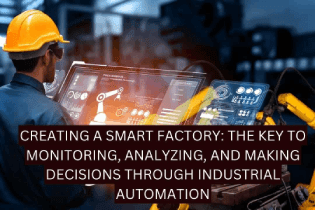Industry 4.0 is the current trend of automation and data exchange in the manufacturing industry as well as the technology that organizations use to produce, enhance, and distribute their products. Manufacturers are integrating new technologies, which include IoT (Internet of Things), cloud computing & analytics, artificial intelligence (AI), and machine learning into their production facilities throughout their operations. By Creating a smart factory with Industrial IoT, they can gather real-time data across the entire supply chain, from suppliers to users, and analyze and use this data to improve your operations, designs, and products by providing instant feedback, thereby improving manufacturing productivity.
Understanding industrial automation
Industrial automation is the use of machines to carry out manufacturing processes with limited human interaction by using different technologies that allow us to monitor and control devices, machinery, or industrial processes.
Manufacturers use machines that are operated through different control systems like programmable logic controllers (PLCs), human-machine interfaces (HMIs), and robotics. Automation uses logic and programming to feed the machine information on how to carry out a certain function.
However, the Industrial Internet of things (IoT) in the automation industry is proving to be a game-changer for automation companies. The Industrial Internet of Things (IIoT) is a subset of IoT that specifically refers to industrial automation. IIoT connects automation devices such as sensors, actuators, and PLCs (programmable logic controllers) to the Internet as well as to each other (which is known as machine-to-machine). This connectivity allows for remote access and monitoring, but more importantly, it allows for data acquisition and collection, exchange, and analysis of different data sources. The ability to link industrial automation to the cloud – and share real-time data – can have a drastic impact on efficiency, production, and uptime, thus contributing to the development of next-generation machines.
Trends in Industrial Automation
The main focus of developments in industrial automation is centered around the capabilities of advanced technology. From environmental concerns to cyber security and the implementation of advanced machinery and intelligent systems, these are the main trends in industrial automation in 2022.
Advanced uses of IIOT – Condition Monitoring
Various industries use different sets of equipment, which can be monitored in real-time with the help of advanced sensor devices and gateways. It is known as condition monitoring, where IoT connectivity enables live analysis to improve the machines’ performance with constant data extraction and report generation.
Predictive maintenance :IIoT empowers equipment condition monitoring in industries with the tool of predictive maintenance. Predictive maintenance is achieved with regular updates and alerts that help plan and schedule maintenance downtimes, re-work / channel changes in the system of procedures, and improvement.
Sustainability :Consumers today are far more likely to purchase products that are made of sustainable materials from reputable manufacturers who take their environmental responsibilities seriously. Here IIoT technologies can help develop solutions to reduce energy consumption, create more efficient machinery, and reduce waste.
Cybersecurity :The cybersecurity strategy has transitioned from a technical problem to business risk. When companies look at cybersecurity in this manner, it removes the mystery and becomes an issue upon which management can act.
Define Smart Industrial Automation Process With Siemens line in Collaboration With SincoS
One of SincoS’ biggest collaborations has been with the automation tech giant Siemens starting in 2010. We partnered with Siemens for a variety of automation components like PLC, HMI, drives, LV/MV, and, most importantly, SCADA technologies. With Siemens Totally Integrated Automation (TIA), the only group of manufacturers able to offer products and systems that automate in all key sectors – from incoming goods to outgoing goods, from field to production control level, and up to a connection with the corporate management level. Some of the products and services that Siemens provide are totally tailored to your needs and are characterized by an exceptionally high level of integration.
Through the Siemens product line, SincoS creates an automation solution for several industries in terms of the following layers: Field devices and instruments layer: Sensors, valves, motors, pneumatics, hydraulics, etc.
Control Layer: Programmable Logic Controllers (PLC), Human Machine Interfaces (HMI), Variable Frequency Drives (VFD), Servo Drives.
SCADA and DCS Layer: Central or Distributed control of process/plant.
Industrial IoT: Remote monitoring and control, Data Analytics, Artificial Intelligence, Productivity Enhancement.
Introducing SincoS Own IIOT Platform “Syncross” For Creating Smart Factory
Since SincoS’ inception in 1983, no turnkey project has been too big or small for them. SincoS comes with fully integrated automation solutions to large-scale industrial equipment and processes using their own IIOT platform (Industrial Internet of Things) for data visualization, analysis, and remote control. It presents a platform for highly customizable dashboards, called “SynCross IIoT Ecosystem ”, that dynamically displays all KPIs, including temperature, flow, pressure, voltage, or current, along with any other KPI the customer desires.
The industrial internet of things (IIoT) uses smart sensors and actuators to measure and control water pressure, level, flow, and other parameters. SynCross has also released its Energy Management Dashboard (EMS) which is ready for deployment and built on top of the SynCross cloud dashboard platform. There are a number of conglomerates in Bangladesh that have adopted the Syncross IIoT ecosystem; companies like British-American Tobacco Bangladesh, Dhaka WASA, Abul Khair Group, and Mainetti Packaging Bangladesh Pvt Ltd have all benefitted from the monitoring, analyzing, and controlling capabilities of the Energy Management System and Utility Management System, both of which are part of the Syncross IIoT ecosystem.
Final Verdict:
Industrial automation refers to the change in technology, industries, and processes in the 21st century due to increased connectivity and automation in all sectors. Siemens and affiliated companies offer private customers a diverse product portfolio, from electrical installation systems and home automation to security systems and hearing instruments as well as investment funds.

